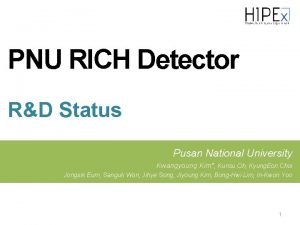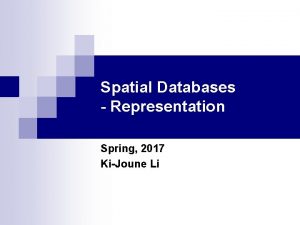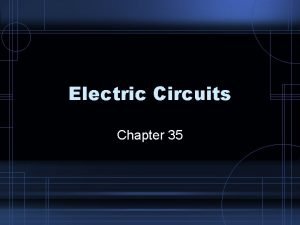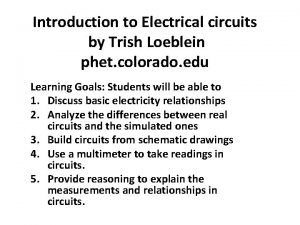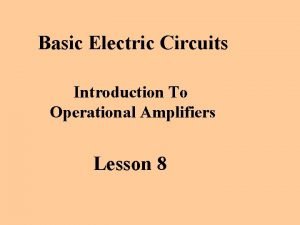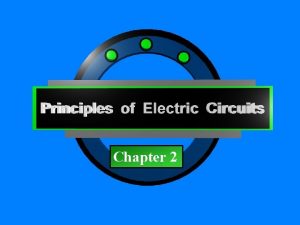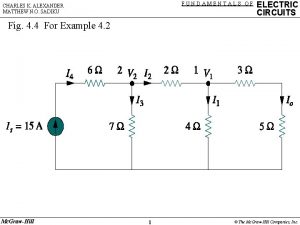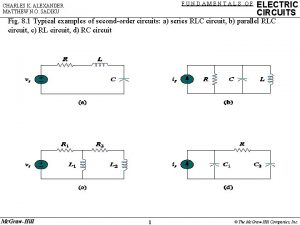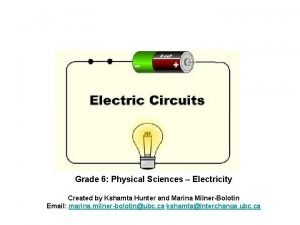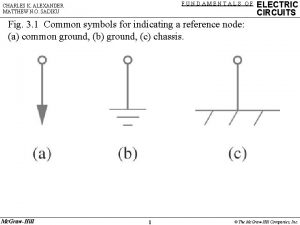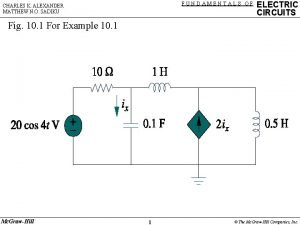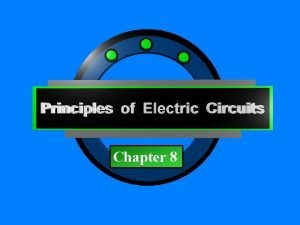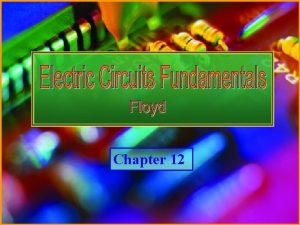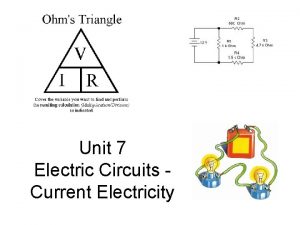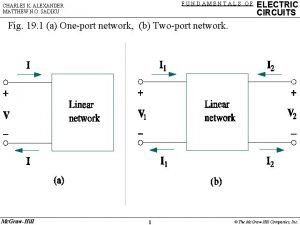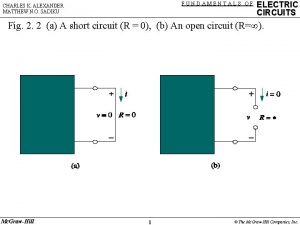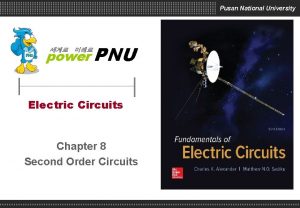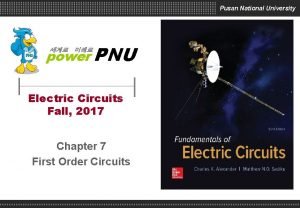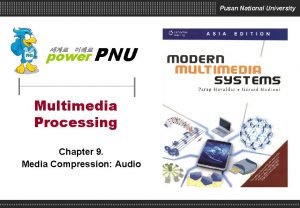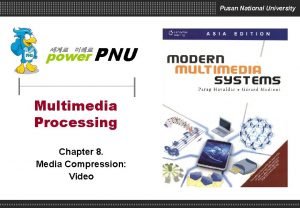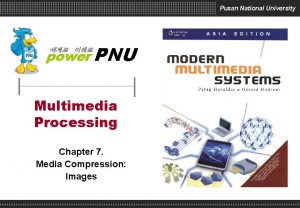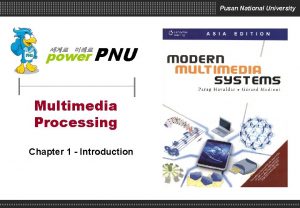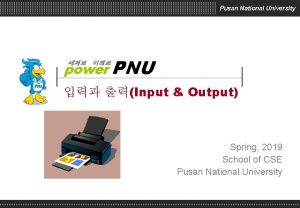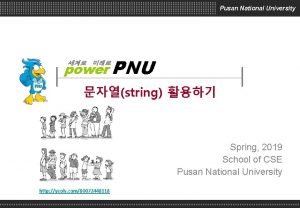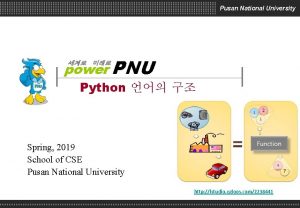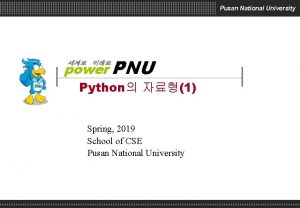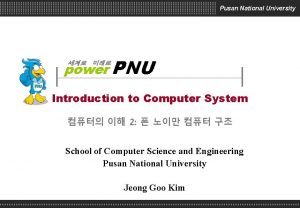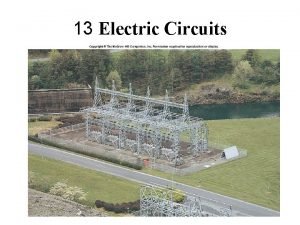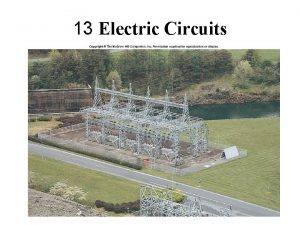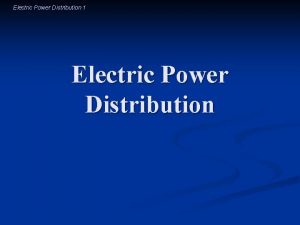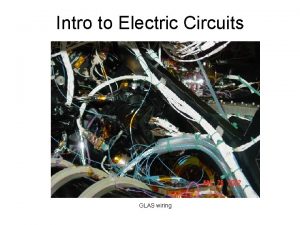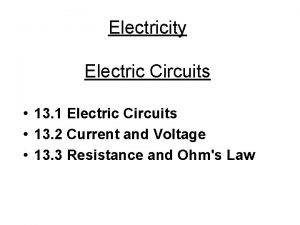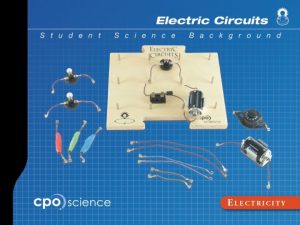Pusan National University power PNU Electric Circuits Chapter

































- Slides: 33

Pusan National University power PNU 세계로 미래로 Electric Circuits Chapter 3 – Methods of Analysis

세계로 미래로 power PNU Overview With Ohm’s and Kirchhoff’s law established, they may now be applied to circuit analysis. Two techniques will be presented in this chapter: Nodal analysis, which is based on Kirchhoff current law (KCL) Mesh analysis, which is based on Kirchhoff voltage law (KVL) Any linear circuit can be analyzed using these two techniques. The analysis will result in a set of simultaneous equations which may be solved by Cramer’s rule or computationally (using MATLAB for example) Computational circuit analysis using PSpice will also be introduced here. Advanced Broadcasting & Communications Lab. 1

세계로 미래로 power PNU 3. 2 Nodal Analysis If instead of focusing on the voltages of the circuit elements, one looks at the voltages at the nodes of the circuit, the number of simultaneous equations to solve for can be reduced. Given a circuit with n nodes, without voltage sources, the nodal analysis is accomplished via three steps: 1. Select a node as the reference node. Assign voltages v 1, v 2, …vn to the remaining n 1 nodes, voltages are relative to the reference node. 2. Apply KCL to each of the n-1 non-reference nodes. Use Ohm’s law to express the branch currents in terms of node voltages 3. Solve the resulting n-1 simultaneous equations to obtain the unknown node voltages. The reference, or datum, node is commonly referred to as the ground since its voltage is by default zero. Advanced Broadcasting & Communications Lab. 2

세계로 미래로 power PNU 3. 2 Nodal Analysis Applying Nodal Analysis Let’s apply nodal analysis to this circuit to see how it works. This circuit has a node that is designed as ground. We will use that as the reference node (node 0) The remaining two nodes are designed 1 and 2 and assigned voltages v 1 and v 2. Now apply KCL to each node: At node 1 At node 2 Advanced Broadcasting & Communications Lab. 3

세계로 미래로 power PNU 3. 2 Nodal Analysis Applying Nodal Analysis II We can now use OHM’s law to express the unknown currents i 1, i 2, and i 3 in terms of node voltages. In doing so, keep in mind that current flows from high potential to low From this we get: Substituting back into the node equations or The last step is to solve the system of equations Advanced Broadcasting & Communications Lab. 4

세계로 미래로 power PNU 3. 2 Nodal Analysis Example Ex. 3. 1 Advanced Broadcasting & Communications Lab. 5

세계로 미래로 power PNU 3. 2 Nodal Analysis Example Ex. 3. 2 Advanced Broadcasting & Communications Lab. 6

세계로 미래로 power PNU 3. 3 Nodal Analysis with Voltage Sources Depending on what nodes the source is connected to, the approach varies Between the reference node and a non-reference mode: Set the voltage at the non-reference node to the voltage of the source In the example circuit v 1=10 V Between two non-reference nodes The two nodes form a supernode. Advanced Broadcasting & Communications Lab. 7

세계로 미래로 power PNU 3. 3 Nodal Analysis with Voltage Source Supernode A supernode is formed by enclosing a voltage source (dependant or independent) connected between two non-reference nodes and any elements connected in parallel with it. Why? Nodal analysis requires applying KCL The current through the voltage source cannot be known in advance (Ohm’s law does not apply) By lumping the nodes together, the current balance can still be described In the example circuit node 2 and 3 form a supernode The current balance would be: Or this can be expressed as: Advanced Broadcasting & Communications Lab. 8

세계로 미래로 power PNU 3. 3 Nodal Analysis with Voltage Source Analysis with a Supernode In order to apply KVL to the supernode in the example, the circuit is redrawn as shown. Going around this loop in the clockwise direction gives: Note the following properties of a supernode: 1. The voltage source inside the supernode provides a constraint equation needed to solve for the node voltages 2. A supernode has no voltage of its own 3. A supernode requires the application of both KCL and KVL Advanced Broadcasting & Communications Lab. 9

세계로 미래로 power PNU 3. 3 Nodal Analysis with Voltage Source Example Ex. 3. 3 Advanced Broadcasting & Communications Lab. 10

세계로 미래로 power PNU 3. 3 Nodal Analysis with Voltage Source Example Practice Problem 3. 3 Advanced Broadcasting & Communications Lab. 11

세계로 미래로 power PNU 3. 3 Nodal Analysis with Voltage Source Example Ex. 3. 4 Advanced Broadcasting & Communications Lab. 12

세계로 미래로 power PNU 3. 4 Mesh Analysis Another general procedure for analyzing circuits is to use the mesh currents as the circuit variables. Recall: A loop is a closed path with no node passed more than once A mesh is a loop that does not contain any other loop within it Mesh analysis uses KVL to find unknown currents Mesh analysis is limited in one aspect: It can only apply to circuits that can be rendered planar. A planar circuit can be drawn such that there are no crossing branches. Advanced Broadcasting & Communications Lab. 13

세계로 미래로 power PNU 3. 4 Mesh Analysis Planar vs Nonplanar The figure on the left is a nonplanar circuit: The branch with the 13Ω resistor prevents the circuit from being drawn without crossing branches Advanced Broadcasting & Communications Lab. The figure on the right is a planar circuit: It can be redrawn to avoid crossing branches 14 14

세계로 미래로 power PNU 3. 4 Mesh Analysis Steps Mesh analysis follows these steps: Assign mesh currents i 1, i 2, …in to the n meshes Apply KVL to each of the n mesh currents. Solve the resulting n simultaneous equations to get the mesh currents Advanced Broadcasting & Communications Lab. 15

세계로 미래로 power PNU 3. 4 Mesh Analysis Example The above circuit has two paths that are meshes (abefa and bcdeb) The outer loop (abcdefa) is a loop, but not a mesh First, mesh currents i 1 and i 2 are assigned to the two meshes. Applying KVL to the meshes: Advanced Broadcasting & Communications Lab. 16

세계로 미래로 power PNU 3. 4 Mesh Analysis Practice Problem 3. 6 Advanced Broadcasting & Communications Lab. 17

세계로 미래로 power PNU 3. 5 Mesh Analysis with Current Source The presence of a current source makes the mesh analysis simpler in that it reduces the number of equations. If the current source is located on only one mesh, the current for that mesh is defined by the source. For example: Here, the current i 2 is equal to -2 A Advanced Broadcasting & Communications Lab. 18

세계로 미래로 power PNU 3. 5 Mesh Analysis with Current Source Supermesh Similar to the case of nodal analysis where a voltage source shared two non-reference nodes, current sources (dependent or independent) that are shared by more than one mesh need special treatment The two meshes must be joined together, resulting in a supermesh. The supermesh is constructed by merging the two meshes and excluding the shared source and any elements in series with it A supermesh is required because mesh analysis uses KVL But the voltage across a current source cannot be known in advance. Intersecting supermeshes in a circuit must be combined to for a larger supermesh. Advanced Broadcasting & Communications Lab. 19

세계로 미래로 power PNU 3. 5 Mesh Analysis with Current Source Creating a Supermesh In this example, a 6 A current course is shared between mesh 1 and 2. The supermesh is formed by merging the two meshes. The current source and the 2Ω resistor in series with it are removed. Advanced Broadcasting & Communications Lab. 20

세계로 미래로 power PNU 3. 5 Mesh Analysis with Current Source Supermesh Example Using the circuit from the last slide: Apply KVL to the supermesh We next apply KCL to the node in the branch where the two meshes intersect. Solving these two equations we get: Note that the supermesh required using both KVL and KCL Advanced Broadcasting & Communications Lab. 21

세계로 미래로 power PNU 3. 5 Mesh Analysis with Current Source Example 3. 7 Advanced Broadcasting & Communications Lab. 22

세계로 미래로 power PNU 3. 6 Nodal and Mesh Analysis by Inspection Nodal Analysis by Inspection There is a faster way to construct a matrix for solving a circuit by nodal analysis It requires that all current sources within the circuit be independent In general, for a circuit with N nonreference nodes, the nodevoltage equations may be written as: Advanced Broadcasting & Communications Lab. 23

세계로 미래로 power PNU 3. 6 Nodal and Mesh Analysis by Inspection Nodal Analysis by Inspection II Each diagonal term on the conductance matrix is the sum of conductances connected to the node indicated by the matrix index The off diagonal terms, Gjk are the negative of the sum of all conductances connected between nodes j and k with j k. The unknown voltages are denoted as vk The sum of all independent current sources directly connected to node k are denoted as ik. Current entering the node are treated as positive and vice versa. This matrix equation can be solved for the unknown values of the nodal voltages. Advanced Broadcasting & Communications Lab. 24

세계로 미래로 power PNU 3. 6 Nodal and Mesh Analysis by Inspection There is a similarly fast way to construct a matrix for solving a circuit by mesh analysis It requires that all voltage sources within the circuit be independent In general, for a circuit with N meshes, the mesh-current equations may be written as: Each diagonal term on the resistance matrix is the sum of resistances in the mesh indicated by the matrix index Advanced Broadcasting & Communications Lab. 25

세계로 미래로 power PNU 3. 6 Nodal and Mesh Analysis by Inspection II The off diagonal terms, Rjk are the negative of the sum of all resistances in common with meshes j and k with j k. The unknown mesh currents in the clockwise direction are denoted as ik The sum taken clockwise of all voltage sources in mesh k are denoted as vk. Voltage rises are treated as positive. This matrix equation can be solved for the values of the unknown mesh currents. Advanced Broadcasting & Communications Lab. 26

세계로 미래로 power PNU 3. 6 Nodal and Mesh Analysis by Inspection Example 3. 8 Advanced Broadcasting & Communications Lab. 27

세계로 미래로 power PNU 3. 6 Nodal and Mesh Analysis by Inspection Practice Problem 3. 9 Advanced Broadcasting & Communications Lab. 28

세계로 미래로 power PNU 3. 7 Nodal Versus Mesh Analysis Selecting an Appropriate Approach In principle both the nodal analysis and mesh analysis are useful for any given circuit. What then determines if one is going to be more efficient for solving a circuit problem? There are two factors that dictate the best choice: The nature of the particular network is the first factor The second factor is the information required Advanced Broadcasting & Communications Lab. 29

세계로 미래로 power PNU 3. 7 Nodal Versus Mesh Analysis Mesh analysis when… If the network contains: Many series connected elements Voltage sources Supermeshes A circuit with fewer meshes than nodes If branch or mesh currents are what is being solved for. Mesh analysis is the only suitable analysis for transistor circuits It is not appropriate for operational amplifiers because there is no direct way to obtain the voltage across an op-amp. Advanced Broadcasting & Communications Lab. 30

세계로 미래로 power PNU 3. 7 Nodal Versus Mesh Analysis Nodal analysis if… If the network contains: Many parallel connected elements Current sources Supernodes Circuits with fewer nodes than meshes If node voltages are what are being solved for Non-planar circuits can only be solved using nodal analysis This format is easier to solve by computer Advanced Broadcasting & Communications Lab. 31

세계로 미래로 power PNU Homework Read Text Chapter 4. pp. 125 -159 Prepare Presentation Solve Problems 3. 6, 3. 12, 3. 22, 3. 36, 3. 41, 3. 49 Advanced Broadcasting & Communications Lab. 32
 Pusan national university uniform
Pusan national university uniform Outlook pnu
Outlook pnu Pnu point
Pnu point Pnu korea
Pnu korea Fundamentals of electric circuits chapter 4 solutions
Fundamentals of electric circuits chapter 4 solutions Electric current
Electric current Chapter 35 electric circuits
Chapter 35 electric circuits Chapter 20 electric circuits
Chapter 20 electric circuits 9
9 Fundamentals of electric circuits chapter 7 solutions
Fundamentals of electric circuits chapter 7 solutions Chapter 35 electric circuits answers
Chapter 35 electric circuits answers Ohm's law and electric power worksheet answers
Ohm's law and electric power worksheet answers Chapter 35 electric circuits
Chapter 35 electric circuits Current in a parallel circuit
Current in a parallel circuit Chapter 21 electric charge and electric field
Chapter 21 electric charge and electric field Chapter 21 electric charge and electric field
Chapter 21 electric charge and electric field Electric field k constant
Electric field k constant Dc o/d per item charge
Dc o/d per item charge Phet build a circuit
Phet build a circuit Electric circuits equations
Electric circuits equations Electric circuits nilsson
Electric circuits nilsson Principle of electric circuit
Principle of electric circuit Electrical circuit elements
Electrical circuit elements Charles k. alexander matthew n. o. sadiku
Charles k. alexander matthew n. o. sadiku Fundamentals of electric circuits
Fundamentals of electric circuits Superposition electric circuits
Superposition electric circuits Kshamta hunter
Kshamta hunter Charles k. alexander matthew n. o. sadiku
Charles k. alexander matthew n. o. sadiku Alexander
Alexander Principles of electric circuits 10th edition answer key
Principles of electric circuits 10th edition answer key Electric circuits fundamentals floyd
Electric circuits fundamentals floyd Circuit symbols
Circuit symbols Fundamentals of electric circuits
Fundamentals of electric circuits Alexander
Alexander

